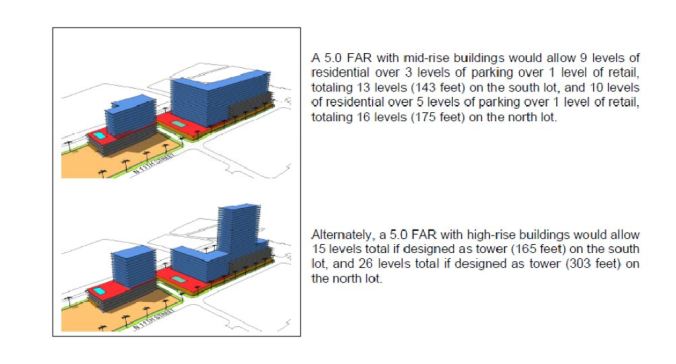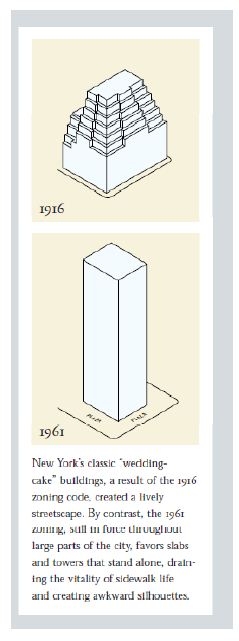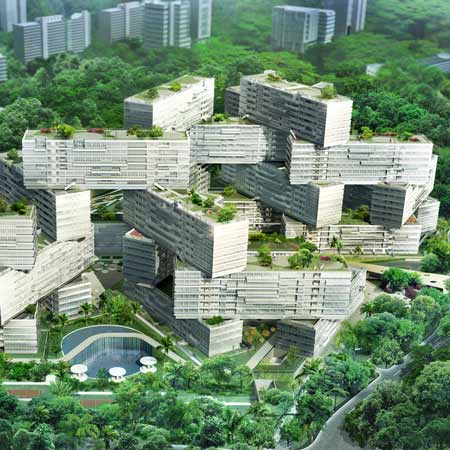International Context
Tools that are known by different terms around the world, floor area ratio, floorspace index, floor lot ratio, plot ratio; despite subtle differences are all essentially the same – a tool that controls ‘Bulk Zoning’ that is the bulk of development on a plot and across a zone. Floorspace Area Ratio (FAR) is the most common term, and is therefore used here as it makes international comparisons easier. This essay looks at the strengths and weaknesses of FAR and in particular how its use can be improved in the MENA (Middle East North Africa) Region.
Definition
The classic definition of Floor Area Ratio (FAR) =
Total covered gross floor area on all floors of all buildings on a plot/area of the plot
The simplicity of the measure is that if that a plot and you know its size then you can multiply one by the other and produce the allowable gross floor area of the scheme. For example if you have a site with a FAR of two you could build on half the site to four storeys, on one quarter of it to eight stories; in the absence of any other controls.
The calculation works in reverse, if you know the maximum allowable floor-space for a use, restricted for example by infrastructure constraints, then if you know a zone area you can set a FAR for that zone. It is this essential simplicity that has led to its widespread use.
Despite this superficial simplicity, in practice its use can be very complex, many jurisdictions have rules defining what counts as allowable gross floor area (for example service and maintenance areas and areas with low eaves heights, on basements and semi-basements), as well as rules as to what counts as permissible area of the plot, for example whether to count parking areas or not. In the USA for example it is common for plans to be accompanied by a certification that the calculations have been done in accordance with the zoning ordinance and staff time amongst planners is very largely devoted to meticulous checking of these calculations.
Example – from the City of Tampa Fl
The Origins of FAR – the reaction against ‘setback’ controls
FAR controls originated for reasons that are not necessarily appropriate to all countries. It is important then to examine the history of the measure.
Masterplanning and zoning of cities to achieve the objectives of the king or ruler go back to ancient times. Modern zoning derives from the desire of several central european rulers at the end of the 19th Century to ‘police’ their urban expansion, a practice brought into the USA during the early years of the 20th Century by lawyers familiar with the use of such ‘police powers’.
‘Bulk zoning’ controls as we know them began in New York in 1916. As New York grew taller and more intense there were concerns about overshadowing and loss of light and of dark ‘canyon’ effects in streets. This was planning in a cold climate. These concerns became tangible with the construction of the Equitable Building.
It was then the largest building, in terms of floorspace, in the world. It has no setback from the street beyond the depth of the sidewalk, rising vertically for all its floors. If one calculates its FAR is 30 (building % 3000%). Opponents were outraged at its unprecedented volume. It cast a 7 acre shadow on the surrounding streets, hurting the value on surrounding plots. Many New Yorkers feared if repeated, Manhattan would become maze of dark and unpleasant streets – a true Gotham City.[1]
In response, the city adopted the 1916 Zoning Resolution which limited the height and required setbacks for new buildings to allow the penetration of sunlight to street level. This ordnance was widely copied in other American cities. This change made the Equitable Building and similar buildings isolated rarities, now largely historical monuments, the street the Equitable Building is on is now known as the ‘Canyon of Heroes’, the street where ticker tape parades are undertaken because of its vertical monumentalism.
The 1916 ordnance predated FAR, its key tool was the building setback, resulting in the famous ‘wedding cake’ skyline of buildings such as the Chrysler Building (1930) and the Empire State building (1931).
The law allowed you build right up to the plot line on your building and then you could rise up to a certain height and then once you reached that height, you had to step back, and then step back again.. There was a formula for how high you could go before you had to set back. The height that you could build up to depended upon the width of the street. On a wide street you could have a street wall that was higher than if you were on a narrow street.
Once you reached 25 percent of your lot area, you could build a skyscraper of any height. So on 25 percent of the lot, you could build a slender tower. This gave New York skyscrapers, built between 1916 and about 1960, their unique profile—a bulky base with setbacks and a slender tower soaring up above – the model for the iconic skyscraper.
It should be noted that the comparatively recent inventions of the RSJ, and of structural engineering calculations for buildings, made these innovations technically possible, whilst the ordnances were well suited to the then fashionable architectural styles of art-deco and neo-gothic.
From the outset these bulk zoning controls had their advocates and fierce critics, and fantasies and analogies to past middle-eastern civilizations was a common theme. There was a fascination with Babylon and the tower of Babel, and setback skyscrapers were often to as modern ziggurats in the “New Babylon of New York.”[2] The writings of Harvey Wiley Corbett, accompanied the illustrations of Hugh Ferris, were influential.
One architect of these times came to regret the urban forms created in the 1920s.
‘ The repetition of the blocks resulted in too much uniformity. Every natural thing was excluded: no tree or grassy area broke the monotony… the result was more a necropolis than a metropolis, a sterile landscape of asphalt and cement, inhuman in every aspect.’
– In the Shadow of Mies: Ludwig Hilberseimer, Architect, Educator, and Urban Planner, p. 17.
Ferris – Zoning Envelope Studies 1922, commissioned by Corbett to illustrate the architectural consequences of the new zoning law. These four drawings would later be used in his 1929 book “The Metropolis of Tomorrow”. The design process is envisioned as subtraction from a virtual mass.
Another critic of these zoning ordinances was Raymond Hood. In the 1920s he argued that instead of the setbacks proposed by Corbett and Ferriss, there should be imagined slender shafts soaring above expansive open spaces – a “modern city of sunlight, air, and free circulation.” He first articulated this idea in 1924 in The New York Times article “City of Needles,” and he continued to promote the concept in numerous places in 1926-1929 in response to the contemporary debate planners over the skyscraper and congestion.
In the drawings prepared for the article “Tower Buildings and Wider Streets,” Hood outlined his response to the growing problem of traffic congestion in midtown Manhattan. He proposed replacing the existing buildings with tall, slender towers surrounded by wider streets. The grid would be replaced by a repeating pattern of two or three towers per block, with fourteen times the amount of street space. Hood’s solution was a proposal to create incentives for developers to build on a smaller percentage of their lots. His new formula proposed a limit on volume based on street frontage: the developer could build a fixed amount higher for each foot that the building was set back from the plot line. Here was the origin of the Floor Area Ratio concept.
It is tempting to see Raymond Hood as a follower of Le Corbusier and the ‘tower in the park’ philosophy. That would be a mistake as in the early 1920s there was as yet little cross fertilization between Paris and New York ideas, rather Hood’s concepts grew up in parallel with those of Le Corbusiers Radient City.
Particularly after the war though, and with the influx of European architects, there was a growing influence of modernist ideas.
Le Corbusier was no fan of grid planning, skyscrapers and the American concept of vertical urbanism, calling it the ‘new medievalism’.
‘Homes to inhabit. The present idea of the street must be abolished: DEATH OF THE STREET! DEATH OF THE STREET!’ …
‘The skyscraper has petrified the cities. In an age of speed, the skyscraper has congested the city. A statement of fact: the skyscraper has reinstated the pedestrian, exclusively. The pedestrian crawls at the feet of those skyscrapers like a beetle at the foot of a steeple.’
The Radiant City, p. 124 & 126.
Floor Area Ratio as the basis for City Centre Planning
By the middle of the twentieth century the 1916 New York ordnances were coming under increasing strain. For example, the city had been built out at the density envisioned in 1916, it could have contained over 55 million people, far beyond its realistic capacity.
Also Le Corbusier’s “towers-in the- park” concepts were influencing planning thinkers, and the concept of incentive zoning—trading additional floor area for public amenities—began to be put forward. The idea was to emulate the perceived success of The Seagram Building is a skyscraper, located at 375 Park Avenue, designed by Ludwig Mies van der Rohe, in collaboration with Philip Johnson, with its public plaza. There was also increasing architectural research on maximizing sunlight, and not just skylight as in the 1916 ordnance.
The firm Harrison, Ballard, and Allen produced a range of studies in 1949, which first set out in detail the concepts of FAR based zoning, but after lengthy public debate, the Zoning Resolution was enacted and took effect in 1961. Though much amended and now bewilderingly complex it is still in place today.
The delay meant that New York was not the first place to introduce FAR, or Incentive zoning, those ‘honours’ lie with Seattle and Chicago respectively. The principles behind the 1961 ordnance were however copied globally.
The City of New York offered developers a higher Floor Area Ratio (FAR) in exchange for creating public plazas at new developments so, in theory, as the city built a world-class skyline, it would also create world-class public spaces. What followed however was many poorly designed and under-used corporate plazas, often with no public access. The concern was not to increase density but to allow more light and air within the same density or even to ‘thin’ the city out at the height of cold war concerns about vulnerability to nuclear attacks.
Source : Municipal Art Society of New York
The “Street Life Project.” By the noted urbanist William H. Whyte’s was crucial in changing the ordnances and thinking about public spaces. By observing and analyzing patterns of pedestrians on the streets and public plazas of New York, Whyte’s study helped New York City Planning Commission understand the value of urban design. Whyte found that the presence of public space was not enough to encourage people to use it; even the much lauded Seagram plaza remained unfriendly and empty, human-scale design and pedestrian-friendly amenities were essential in creating vibrant public spaces. While Whyte’s work, as well as the work of his famous mentee, Jane Jacobs, was widely read in planning circles, it took several decades for cities to incorporate is notions of how design influences use into street design standards and policies. In 1971 the New York Zoning ordinances were amended to incorporate many of his ideas.
As New York’s own department of planning states ‘Tower-in-the-park zoning encourages the construction of tall buildings set back from the street, by allowing greater height and more floor area in return for the provision of open space. The resulting buildings have been subject to widespread criticism as anti-urban and disruptive of the dominant form and scale of most of the city’s neighborhoods that were built largely under the original 1916 Zoning Resolution.’[3] In the words of City Planning Chairman Joseph B.Rose, it “promotes an architectural vision that does violence to our urban fabric.”[4]
Donald Trump built the Trump World Tower, a FAR building of 38 on a site with a FAR zoning of 10, next to and higher than the United Nations building. The Red (TDR) and Yellow (incentive) illustrate how misuse and excessive use of transferable development rights and incentive zonings, without overall caps on height, produce a building out of scale and context Source : Municipal Art Society of New York
The way that FAR is used in MENA is a relic of the discredited modernist theory of ‘towers in the park’ – which undermined the concept of planning for streets. But the MENA region got towers but not parks, it got streets, but not ones that were usable or walkable. The voids that FAR was supposed to create were designed to increase sunlight and skylight, but in the intense heat they are the very things that should be minimized. FAR is supposed to match development volumes to transport and other infrastructure, but in MENA FAR has been increased ‘to the sky’ with limited public transport system. FAR, as used in MENA, is a dysfunctional, discredited and inappropriate tool producing perverse outcomes, it is a recipe for congestion and visual chaos.
Problems with and Criticisms of FAR based controls internationally
- FAR by itself allows or even encourages the ‘stacking’ of mass in one corner or one part of a site to achieve height. This ‘precinct planning’ can disrupt streets lines, reduce enclosure of streets and harm genuine urban character.
- FAR is just a ratio of floorspace and site area, but this presumes that controlling factors are equally important, and in the same proportion across every part of a zoning district. In urban design terms this is very unlikely to be the case. For example on corner plots higher buildings may be more appropriate, and at zoning district edges there needs to be a transition in building heights (succession zoning). Also at key positions like end points of vistas there may be cases for increased massing, but this kind of ‘design-led’ bulk zoning is not intrinsic to FAR based controls and traditional bulk zoning plans.
- A related problem is that it is not directly controlling a planning outcome, other than, to a degree, traffic generation, it controls mass but not form or design. Andreas Duany notes that abdicating to floor area ratios is the opposite of aiming a community toward something more than the sum of its parts. FAR, a poor predictor of physical form, should not be used when the objective is to conserve and enhance neighborhood character. Whereas traditional design standards (height, plot coverage and setbacks or build-to lines) enable anyone to make reasonably accurate predictions, recognise violations, and feel secure in their investment decisions.
- Different land uses can have different bulks for the same floor area because of different floor to ceiling heights between land uses.
- It is difficult for it to be simultaneously a controller of bulk and a controller of infrastructure demand, because different land uses have different impacts, such as traffic generation per unit floor area.
- Zoning plot mergers enable developers to assemble small lots into the larger merged plots needed to build some kinds of efficient, economical new buildings, such as large footplate offices for financial services. The mergers also provide an incentive to preserve small existing buildings of character that are not built to the full permitted floor area, by enabling the transfer of the unused floor area from the site of a small existing building to the development site. Additional controls must be placed on zoning plot mergers, however, to avoid the transfer of excessive amounts of floor area to a development site from the already developed portion of a merged zoning plot. Transfers of floor area that go too far can produce buildings out-of-scale with their neighbors, requiring complex rules in some jurisdictions. Also in some jurisdictions ‘gaming’ of zoning is common when the area of the application is different from the development, and complex rules are needed to prevent unused air-rights being counted twice.
- The flipside of this is stressed by Andreas Duany, if FAR is carelessly combined with traditional setbacks, assembled plots have a considerable advantage over individual plots, which has a negative effect on fine grained cities and the diversity of ownership. The issue is what kind of ‘grain’ of city you wish to promote, a souk might require a very different grain than a financial services CBD.
- Many development sites straddle zoning district. Some jurisdictions have rules governing the development of these “split plots” which are confusing and too permissive. As a result, split plots have provided an excuse for erasing the distinctions between different zoning districts, transferring inappropriately large amounts of floor area and producing oversized buildings. The confusing zoning split in the Manama CBD between public service and BA is almost certainly hindering land assembly in an area badly needing co-ordinated regeneration. Manama needs to create in its CBD the kind of ‘walkable core’ north of the Souk which would form the heart of a transit network which any sustainable city region plan requires.
- Incentive zoning floor area bonuses for residential plazas and certain other public spaces, have too often produced larger buildings without always providing meaningful public benefits.
- New commercial buildings contain increasingly sophisticated technology. Much of the space occupied by this equipment is treated as “mechanical space” and can often be deducted from the zoning floor area of a building under many zoning ordnances. In some cases, these deductions can amount to more than a quarter of a building’s floor space and so have enabled a building to become much larger than is contemplated in the zoning. It is certainly desirable for new buildings to use the new technology and appropriate that a reasonable amount of mechanical space be deducted from floor area calculations, but these deductions should not become so large that they subvert bulk zoning controls.
- Excessive use of incentive zonings and transferable development rights (a full discussion of which is beyond the scope of this paper) can undermine public confidence. There have been a number of ‘cause celebres’ in different cities which have highlighted this issue.
- Maximum FAR controls by themselves do not guarantee high density development, some very low density development can result (as we see in Juffair) suboptimal in terms of land use and incongruous in character.
- Where FAR controls are too low they can result in a suboptimal distribution of density, pushing sitting out in a way which is expensive to service (despite initial concerns to match population to density), making housing less affordable to the poorest, and making urban labour markets less accessible. This is born out in more than 30 years of studies by the noted urbanist/economist Alan Bertaud[5], and much urban modeling work in Japan[6].
- Use of FAR poses especial difficulties on the coast where site boundaries can be expanded considerably through land reclamation.
There are also potential advantages; in particular potential predictability of volumetrics enables detailed testing of viability of a scheme at an early stage. Despite this advantage the tendency to put volumetrics over form can produce its own problems in not creating to shaping usable public space. This is perhaps most evident in the ‘cutting up polystyrene blocks’ school of thought, as practiced by Rem Koolhaus and anyone else educated at the Architectural Association in London.
OMA – Rem Koolhaus – volumetrics triumphs over urbanism, ‘The city can no longer be made…we only have architecture’ Below OMA scheme for Dubai, or in Mike Davis’s words ‘Walt Disney meets Albert Speer…on the Coast of Arabay’
Or Generative Urbanism urbanism shapes volumetrics – Zaha Hadid Studio[7]
How High is to the Sky? – some international comparisons
It is useful to consider comparable FARs in other places. Some of the below are not bulk zoning controls but analysis of existing morphologies (marked with a star* – taken from the Car free cities Design Manual[8]).
Note: Because these are calculated in different ways in different cities ‘exact’ comparisons are not possible. Although efforts have been made to baseline comparisons by defining the maximum that could be achieved once any incentive zoning and TDR bonuses are included many codes are very complex and additional bulk might be possible in some circumstances, and in addition extra height controls might make some theoretical bulks difficult to achieve in some circumstances. Some of the figures (such as for Singapore) seem lower than one would expect and this may bbe because of complex definitional issues.
San Marco, Venice 2.85*
Central Amsterdam 1-9-2.4*
Car Free Cities Manual Reference FAR 1.52 (designed to encourage walkability and based on pre-industrial cities)
Paris 3
Bankok 8 (maximum CBD)
Singapore 2.8 maximum, with a height control of 36 stories (limited exceptions)[9]
Vancouver 2.5 maximum, discretionary exemptions and incentive bonuses can lead to greater development. Note this city has the highest density of residential occupancy in north America, higher than Manhatten[10]. A push towards higher densities in single family zoned areas through an ‘ecodensity’ programme was highly controversial. High residential land prices in the core has led to some businesses being forced out of downtown.
Indian FARs are low, above 2 is very rare – the historical aim has been to keep down heights because of scale and cost of infrastructure required to support high rise and in some cases lack of resources/unwillingness to make that kind of investment.
Denver Colorado – 17 downtown, 12 downtown fringes, very sophisticated additional controls including height limits.
New York – Downtown, typically 10-15, very highest area, Lower 5th Avenue special district 23. By example the Rockerfeller Centre has a FAR of 12.
Hong Kong – 12 in Hong King Island Urban Area, was 15 for commercial but reduced to 12 in 2008 over concerns that the island was becoming overdeveloped [11].
Los Angeles CBD – 13
Chicago, Highest in new planned districts of CBD 12
Bahrain – 17 – in densist districts, following a decrees by the prime minister to allow building ‘to the sky’ following lobbying from landowners.
San Francisco – Highest 9 in some CBD zones for commercial[12].
Sao Paulo – 1 – as of right, additional up to 2 to 5 depending on zone, achieved through a system of incentive zoning and TDR[13]. There are also height restrictions of 150m because of fire safety concerns. The impression of central Sao-Paulo as a ‘super dense’ city is misleading. The highest zoning produces a fairly uniform pattern of 20-25 storey buildings with regular spacing, but a FAR much less than the average density of for example Manhatten (average as actually built across the whole of Manhattan FAR 6.8), and less than half that of the urban part of Hong Kong Island. These densities however were sufficient to create such traffic congestion that there was a ‘flight’ of businesses away from the CBD, and companies in the new office core typically face ½ hour queues leaving premises.
Sao Paulo
The award winning Miami 21[14] code uses FAR type control is only used for the densest urban zones, this is combined with height controls and build to requirements. Incentive zoning is used to add extra FAR and storey’s according to a formula, and subject to maximums (except in the very densest zones). The system is known as FLR3. Bonuses can be multiplied by a factor if there is an especial need e.g. open space deficiency. There are footplate limits for buildings above the eigth storey, not for purposes of sky exposure but inspired by German rules which require penetration of natural light for office workers. Only the area of land under ownership is counted towards development capacity.
Floor Lot Ratio is development capacity based only on gross building area, including parking and mechanical areas. The aim was to have an easily definable development capacity that residents could calculate without requiring a land-use attorney or architect to decipher.
Potential Means of reducing the disadvantages of Floor Area Ratio Controls
There are ways in which each of the specific disadvantages of FAR can be mitigated in those zoning districts (and future areas) where it might be needed.
–The ‘Precinct Planning’ Problem, set out rules for ‘build to lines’ to the plot boundary (or adjusted plot boundary if a setback for wider footways is needed), across a minimum proportion of the frontage. There might be exemptions for dedicated public open space.
–The Height Modulation Problem, in some zoning districts (depending on character) allow a site area bonus based on half width of boundary roads (to a maximum width) which will boost heights on corner sites. Introduce pre-application procedures, with design review for medium/larger projects, on the Abu-Dhabi model, so that urban design analysis forms the foundation for the working up of larger schemes. Introduce rules on succession zoning (modulated building heights) at zone edges to lower density districts (and edges of historic districts overlay zones).
–The Lack of Control over Form Problem, Introduce form based zoning, more strongly in areas where control over form is necessary, such as new towns and urban extensions being designed according to a masterplan, or in areas where traditional forms should be replicated.
–The Different Bulk of Land Uses Problem, have a reduction factor for land uses with higher floor to ceiling heights than residential, or alternatively have a maximum storey height for assessment purposes so that floorspace with very high floor to ceiling heights (shopping malls, large ground floor office atriums, has floorspace in these storey’s counted at more than a factor of 1).
–The Differing Impact on Bulk and Land Use Problem, Each zoning district ‘street block’ could be assigned a maximum traffic generation factor pool based on infrastructure constraints in place during any one phasing period. Schemes would be assessed on their impact, (including reduction factors for trip generation based on the research findings of trip reduction in mixed use developments for ‘linked trips’). Once this was depleted then other schemes in the block could only development ‘as of right’ land uses such as medium density residential and ground floor small commercial, unless potentially they could enlarge the ‘pool’ by incentive zoning payments to bring forward transit etc. or could reduce their impact through reducing parking and/or relying on shared parking. Essentially this would be a twin track approach, control infrastructure at block or street block level and control bulk at the plot level. Like in many circumstances it would be an incentive for early development. Concerns over the theoretical build out capacity of zones are real but can be exaggerated in scale, many areas will not be built out to capacity. For example in Tokyo over many years the theoretical build out capacity of zoned land is about twice the maximum amount of development planned for in the region. This is understood and has not caused a problem.
–The Using Extra Buildings to increase Height Problem; Do not allow transfer of airights outside the same ownership or from a non-contiguous site (unless under any TDR rules). Introduce additional height controls in sensitive areas.
–The Fine Grain Disincentive Problem, assess an urban area for its character and ensure that there are zoning district rules (or overlay zoning rules) that encoyrage small lot renovation and development and replicate this form where necessary.
–The Split Plot Problem, treat FAR separately each side of the split plot. Do not have split zoning districts in areas requiring more comprehensive treatment (e.g. Manama CBD), instead use overlay zoning to control impact on sensitive areas.
–The Excessive Incentive Zoning Problem, In sensitive areas ensure that incentives have a cap. The converse issue is that ‘as of right’ FAR should not be set so high that incentives never kick in.
–The Mechanical Space problem, Have a strict limit on the maximum proportion discounted – such as 10% of total floor area.
–The Low Density in High FAR districts problem, introduce minimum as well as maximum FARs
–The capping FAR leads to Unaffordable Housing problem, can only be solved at a strategic scale, through modeling and testing of alternative strategic options and ensuring sufficient land is delivered at the right time in the right areas.
–The Coastal Problem, ensure special controls on setback and coastal access as overlay districts. Set a permanent coastal reclamation limit.
Using Bulk Zoning Controls to Reduce Heat Exposure
Given that FAR was created to mandate void at upper storey levels to increase exposure to sky and sun in areas such as MENA, how do we reshape it as a tool to reduce thermal expose and glaze, to modulate heat and ensure architectural variety?
Potential ideas could include:-
-Excluding ground floor arcading, and internal vaulted streets with public access from FAR calculations
-Exclude fina space structures and exterior wall thicknesses from FAR calculations to encourage thick heat absorbing walls and a varied street wall.
-Exclude traditional interior solar vaults/atriums from FAR calculations (to a limit) where these encourage natural ventilation
-Exclude wind scoops and wind towers from FAR calculations[15]
-Excluding shading devices such as pergolas and brise-soleil from FAR calculations.
-Requiring build to to the frontage for the ‘base’ part of the building (up to perhaps 6 storeys) to encourage solar shading.
-Requiring regular interior through pedestrian routes, especially aligning to prevailing winds, to encourage wind harvesting
-Setting maximum footplates, and minimum separation for towers above ‘base’ to encourage wind harvesting
-Requiring a regular grid of shaded, fountain ventilated courtyards on the ground plane
-Controlling roof albedo, with FAR bonuses for Green Roofs, perhaps on the Berlin model[16] or utilising the idea of ‘green plot ratio’ by Dr Lay in Singapore[17] or Seattle’s ‘Green Factor’[18].
-Requiring angular setbacks for upper floor glazed areas to control glare and encourage pergola roof geometries which reduce thermal overheating at the hottest times of the year.
[2] Zoning and “Zeitgeist”: The Skyscraper City in the 1920s, Carol Willis, Journal of the Society of Architectural Historians, Vol. 45, No. 1 (Mar., 1986), pp. 47-59 (article consists of 13 pages)
[4] Zoned Out , A call to reform New Yorks Zoning Laws http://www.tenant.net/land/zoning/unifiedbulk/zoningbookfile.pdf
[6] Evaluating land-use restrictions concerning the floor area ratio of lots Xiaolu Gao, Yasushi Asami & Wataru Katsumata, Urban Planning Depart Environment and Planning C: Government and Policy 2006, volume 24, pages 515 – 532
[7] Parametricism – A New Global Style for Architecture and Urban Design
Patrik Schumacher, London 2008, Published in: AD Architectural Design – Digital Cities, Vol 79, No 4, July/August 2009,
[11] South China Morning Post 9th April 2008,
[13]Urban Planning, Innovations from Brazil, Nov 1994, Berkely Centre for Latin American Studies Working Paper .11 http://escholarship.org/uc/item/9vn1r7f1
[15] Housing Climate and Comfort M Evans 1980








hi please if you can give detail for planning of malls in residential building ( recommendation)
your friend
maria
Hello Lainton,
I am an engineer student from Sweden. I wonder if you hold the rights for the black and white picture “image009” on Sao Paolo? The picture would be perfect for our schoolproject’s webpage.
Kind regards,
Sara Andersson
I truly love your blog.. Pleasant colors & theme.
Did you create this website yourself? Please reply back as I’m hoping to create my own personal website and would love to learn where you got this from or what the theme is called. Thank you!
Admiring the hard work you put into your website and detailed information you offer.
It’s awesome
to come across a blog every once in a while that isn’t the same old rehashed material.
Excellent
read! I’ve bookmarked your site and I’m adding your RSS feeds to
my Google account.
If you wish for to take a great deal from this paragraph then you have
to apply these strategies to your won web site.
Pingback: The Birth and Growth of Modern Zoning (Part III): FAR and Wide - Skynomics Blog